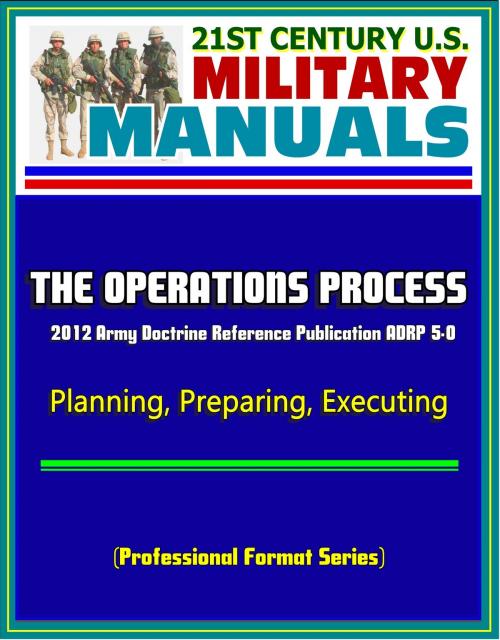21st Century U.S. Military Manuals: The Operations Process - 2012 Army Doctrine Reference Publication ADRP 5-0, Planning, Preparing, Executing (Professional Format Series)
Nonfiction, History, Military, United States| Author: | Progressive Management | ISBN: | 9781301916801 |
| Publisher: | Progressive Management | Publication: | November 30, 2012 |
| Imprint: | Smashwords Edition | Language: | English |
| Author: | Progressive Management |
| ISBN: | 9781301916801 |
| Publisher: | Progressive Management |
| Publication: | November 30, 2012 |
| Imprint: | Smashwords Edition |
| Language: | English |
Professionally converted for accurate flowing-text e-book format reproduction, Army doctrine reference publication (ADRP) 5-0 augments the principles of the operations process found in Army doctrine publication (ADP) 5-0, The Operations Process. It provides an expanded discussion of planning, preparing, executing, and assessing operations. Together with ADP 5-0, this ADRP establishes a common frame of reference and language that commanders and staffs use for the exercise of mission command.
ADRP 5-0 is a new publication that expands on the principles of the operations process found in ADP 5-0. Overall, the doctrine in ADRP 5-0 remains consistent with Field Manual (FM) 5-0, The Operations Process. The most significant change from FM 5-0 is the restructuring of doctrinal information.
Chapter 1 describes the nature of operations in which commanders, supported by their staffs, exercise mission command. Next, this chapter defines and describes the operations process. A discussion of the principles commanders and staffs consider for the effective execution of the operations process follows. The chapter concludes with discussions of the integrating processes, continuing activities, battle rhythm, and running estimates. The following are significant changes from FM 5-0 in chapter 1. The principles of the operations process now include
• Commanders drive the operations process.
• Build and maintain situational understanding.
• Apply critical and creative thinking.
• Encourage collaboration and dialogue.
Chapter 1 * FUNDAMENTALS OF THE OPERATIONS PROCESS * The Nature of Operations * Mission Command * The Operations Process * Principles of the Operations Process * Integrating Processes and Continuing Activities * Battle Rhythm * Running Estimates * Chapter 2 * PLANNING * Planning and Plans * The Value of Planning * Integrating Planning * Operational Art And Planning * Army Planning Methodologies * Key Components of a Plan * Guides to Effective Planning * Planning Pitfalls * Chapter 3 * PREPARATION * Preparation Activities * Guides to Effective Preparation * Chapter 4 * EXECUTION * Fundamentals of Execution * Responsibilities During Execution * Decisionmaking During Execution * Rapid Decisionmaking and Synchronization Process * Chapter 5 * ASSESSMENT * Assessment and the Operations Process * The Assessment Process * Guides to Effective Assessment * Assessment Working Groups * Assessment Support
As a bonus, this reproduction includes the complete 2012 Army Leadership manual (FM 6-22), which describes the Army's view of leadership, outlines the levels of leadership (direct, organizational, and strategic), and describes the attributes and core leader competencies across all levels.
Professionally converted for accurate flowing-text e-book format reproduction, Army doctrine reference publication (ADRP) 5-0 augments the principles of the operations process found in Army doctrine publication (ADP) 5-0, The Operations Process. It provides an expanded discussion of planning, preparing, executing, and assessing operations. Together with ADP 5-0, this ADRP establishes a common frame of reference and language that commanders and staffs use for the exercise of mission command.
ADRP 5-0 is a new publication that expands on the principles of the operations process found in ADP 5-0. Overall, the doctrine in ADRP 5-0 remains consistent with Field Manual (FM) 5-0, The Operations Process. The most significant change from FM 5-0 is the restructuring of doctrinal information.
Chapter 1 describes the nature of operations in which commanders, supported by their staffs, exercise mission command. Next, this chapter defines and describes the operations process. A discussion of the principles commanders and staffs consider for the effective execution of the operations process follows. The chapter concludes with discussions of the integrating processes, continuing activities, battle rhythm, and running estimates. The following are significant changes from FM 5-0 in chapter 1. The principles of the operations process now include
• Commanders drive the operations process.
• Build and maintain situational understanding.
• Apply critical and creative thinking.
• Encourage collaboration and dialogue.
Chapter 1 * FUNDAMENTALS OF THE OPERATIONS PROCESS * The Nature of Operations * Mission Command * The Operations Process * Principles of the Operations Process * Integrating Processes and Continuing Activities * Battle Rhythm * Running Estimates * Chapter 2 * PLANNING * Planning and Plans * The Value of Planning * Integrating Planning * Operational Art And Planning * Army Planning Methodologies * Key Components of a Plan * Guides to Effective Planning * Planning Pitfalls * Chapter 3 * PREPARATION * Preparation Activities * Guides to Effective Preparation * Chapter 4 * EXECUTION * Fundamentals of Execution * Responsibilities During Execution * Decisionmaking During Execution * Rapid Decisionmaking and Synchronization Process * Chapter 5 * ASSESSMENT * Assessment and the Operations Process * The Assessment Process * Guides to Effective Assessment * Assessment Working Groups * Assessment Support
As a bonus, this reproduction includes the complete 2012 Army Leadership manual (FM 6-22), which describes the Army's view of leadership, outlines the levels of leadership (direct, organizational, and strategic), and describes the attributes and core leader competencies across all levels.















